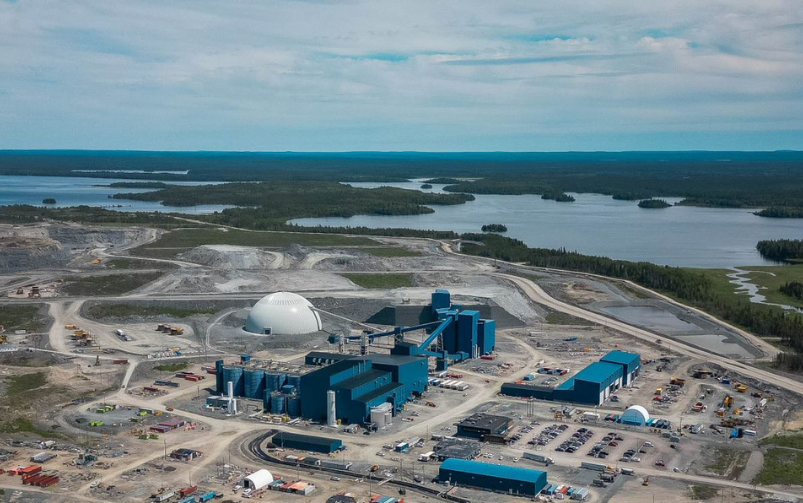More than 500 unionized workers went on strike at Taseko Mines’ Gibraltar mine in B.C., which is Canada’s second largest open-pit copper mine. Courtesy of Taseko Mines.
Welcome back to your weekly mining news recap, where we catch you up on some of the news you may have missed. This week’s headlines include Red Pine Exploration’s new checks and balances for drill assay reporting, Canadian mining projects snagging the top spots in a new report on the world’s most attractive projects and Yukon considering subsidies to help mining companies reduce emissions.
Taseko Mines Limited has paused operations at its Gibraltar mine in British Columbia following the start of a worker strike, as reported by The Canadian Press. After no deal was reached during negotiations for a new contract between the miner and its unionized workers before the collective agreement expired on May 31, roughly 550 workers walked off the job over the weekend. The company announced on June 1 that it had shut down mining and milling operations, and put the mine into care and maintenance with a skeleton crew overseeing essential functions at the mine.
CIM Magazine’s Names to Know is an annual feature which highlights notable people who are making waves in the mining industry. This year’s list, which was published in the May 2024 issue, includes Jean Hutchinson, a geological engineer and professor promoting inclusivity in the industry; Sabrina Bouchard, who has played a key role in advancing Quebec’s electric vehicle battery strategy, namely in the province’s Mauricie and Centre-du-Québec regions; and Jack Milton, who used innovative technologies to make a significant geological discovery in eastern Yukon.
Red Pine Exploration announced that it will implement quality control changes to its assay reporting process, following its accusations that former CEO Quentin Yarie altered drill assay results, as reported by Northern Ontario Business. As part of its new protocol, the company plans to send certificates from the assay lab for the company’s Wawa gold project to a minimum of two members in its senior management team, while also ensuring the lab results are obtainable through a web portal.
Freeport Indonesia has increased its copper output guidance for 2024 while it waits on the government for an extension of its copper concentrate export permit, as reported by Reuters. The company raised its guidance to 3.78 million tonnes from 2.84 million tonnes, which is contingent on the extension receiving approval.
Diamond miner De Beers—which launched its own lab-grown diamond jewellery brand in 2018 in an attempt to compete with other synthetic diamond producers—plans to stop manufacturing synthetic diamonds and instead refocus on natural diamonds, as reported by Bloomberg. This decision comes following its parent company Anglo American’s plan to sell or spin off De Beers, which was announced last month as Anglo attempted to fend off rival BHP’s takeover bids. Following news of Anglo’s plans for De Beers, the Botswana government is considering the possibility of raising its stake in the diamond miner. The government’s current stake in De Beers is 15 per cent. De Beers currently mines 70 per cent of its annual rough diamond supply in Botswana.
Canada came out on top in a new report from Mining Journal Intelligence, which highlighted the 50 most attractive mining projects across the globe. The projects were ranked using a scoring method based on six different factors: economics, jurisdiction, confidence, financeability, engineering/metallurgy and geology. The report examined over 450 projects, and three Canadian projects ranked at the top of the list. Denison Mines’ Phoenix (Wheeler River) and NexGen Energy’s Rook I, both uranium projects in Saskatchewan, ranked first and second, and Skeena Resources’ Eskay Creek gold project in British Columbia ranked third. Note to readers: the report is paywalled.
A toll milling agreement has been reached between Magna Mining and Glencore Canada to process ore from Magna’s Crean Hill nickel-copper project in Sudbury, Ontario, at Glencore’s nearby Strathcona mill, as reported by Canadian Mining Journal. Around 20,000 tonnes of ore from the 109 footwall zone at Crean Hill will be shipped to the Strathcona mill to be processed, where a bulk concentrate will then be produced. This agreement will aid Magna in better understanding the ore’s quality as the company prepares for deeper exploration at Crean Hill.
A study conducted by management consulting firm Bain & Company has revealed that the majority of mining and energy projects end up running 15 to 20 per cent over budget, as reported by Mining.com. As a result, the company stated that for the average company in these sectors, around US$1.5 billion of capital invested in projects related to the global energy transition are at risk each year until 2030.
Yukon’s government is mulling over whether to subsidize mining companies with the aim of aiding them in reducing emissions, as reported by CBC News. A submission from Yukon’s energy department to the territory’s cabinet committee last summer stated that these subsidies could be necessary for the mining industry to meet what it called “aspirational” emissions reduction targets, which the government is currently developing.
That’s all for this week. If you’ve got feedback, you can always reach us at editor@cim.org. If you’ve got something to add, why not join the conversation on our Facebook, Twitter, LinkedIn or Instagram pages?




